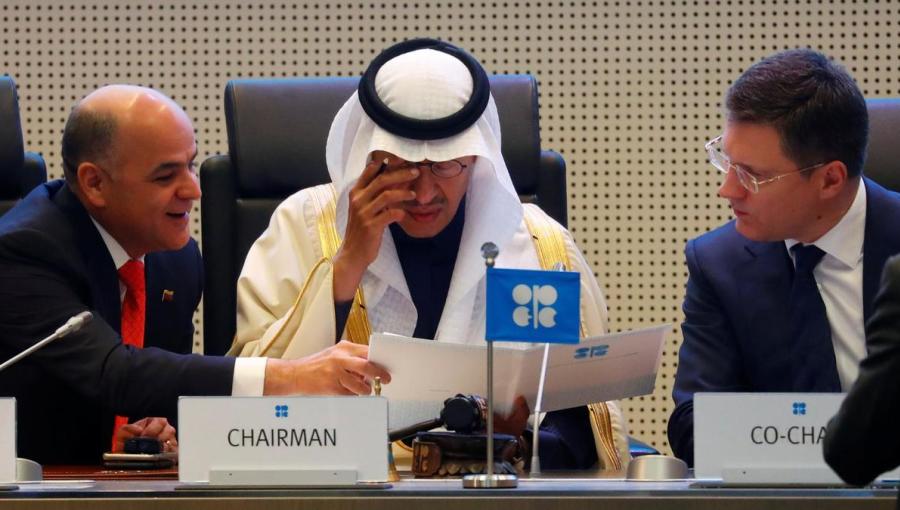
Oil prices have plummeted in recent days as a result of the collapse of negotiations between OPEC and Russia to continue agreed upon production cuts to oil, which would have kept prices more stable.
According to reporting by both Ben Aris and Chris Weafer, Russia decided to let prices drop in order to end what they considered to be buoying of the U.S. shale industry. According to Weafer:
At last week’s meeting, Russia only offered to extend the existing OPEC+ deal, which is set to expire at the end of this month, for a three further months and then to assess the situation. Saudi Arabia wanted Russia to participate in cutting an additional 1.5mn barrels per day (bbl/d) through Q2 in order to try and balance the global oil market. Having been rejected by Moscow, Saudi has responded very quickly with an announcement that it has no intention of extending the current deal and will “open up the oil taps” from April 1. It is already reported that the Kingdom is offering discounted oil.
At first glance, this looks like a battle between Russia and Saudi over oil policy. But the context of the relentless rise in US oil production over the past ten years is also an important factor. Both Russia and the major OPEC producers have been openly annoyed with the refusal of the US producers to participate in past production cuts and the fact that the US industry has been the major beneficiary of the price support mechanisms. It is a stretch to say that Moscow and Riyadh are in any sort of cooperation to try and reduce US oil production; the body language at the Vienna meeting strongly suggests otherwise. But if a price war results in some US casualties and a greater reluctance by investors and lenders to fund future US marginal production, then Moscow and OPEC will be relieved.
The coronavirus has already cut global demand for oil in conjunction with a general economic slowdown. This all is giving rise to the question of what countries are best prepared to withstand a low oil price. The usual suspects in the west will contend that Russia will be in deep trouble if this goes on for any length of time. After all, they are simply a gas station posing as a country, right?
As I’ve discussed in previous posts, Russia has intentionally implemented economic policies to shield itself from economic instability. With oil sales only comprising 35% of Russia’s budget now, they are in a much better position to withstand lower oil prices than Saudi Arabia. Weafer explains:
Russia has had to allow the ruble free-float from early 2015. This was a policy forced on the Kremlin as a result of the combination of western sanctions and low oil. That has turned out to be a major silver-living for the budget, as well as for economic competitiveness, and it means that the budget break-even oil price moves lower as the ruble weakens. Assuming the ruble-dollar exchange rate drops below 70 then the breakeven will drop to $45 per barrel. If the ruble-dollar rate hits 75 then the budget will breakeven around $40 per barrel without any cuts to current planned spending. This compares with a breakeven of $115 per barrel in 2013.
Saudi Arabia reportedly needs $85 per barrel to balance its budget and does not gain from a currency offset as the Riyal is pegged to the dollar.
Russian oil producers now have a very low production cost, exactly for the same reason of the ruble flexibility and also efficiency gains that the industry also had to adopt because of western sanctions.
Aris adds the following details on what the Putin government has done in terms of buffeting the Russian economy against potential instability:
Russian President Vladimir Putin has spent much of the last four years building a “fiscal fortress” to sanction-proof Russia. He has sold down Russia’s US debt holdings, paid off debt and built up gross international reserves (GIR) to around $570bn now – enough to cover Russia’s entire external debt and still leave $100bn of cash. Moreover, a revolution of Russia’s tax service and new taxes, as well as a hike to the retirement age, have cut the breakeven oil price for the budget to around $42 from its peak of $115 in the boom years. All this means Russia can sustain a long war of attrition on US shale production.
In response to the drop in oil prices earlier this week, U.S. president Trump suggested the possibility of a government bailout of the shale industry, which is mired in debt and could be in deep financial trouble if the oil price drop lasts for any length of time. Common Dreams reported that executives from the industry had already reached out to the Trump administration to request assistance:
The administration began weighing a bailout after Trump supporter Harold Hamm—a Trump supporter whose company’s stock plunged Monday, losing Hamm $2 billion of his 77% of the company’s shares—reached out to the administration. Hamm confirmed the conversation to the Post.
Hamm was not alone—the Post revealed that a number of executives have made overtures to the White House on policy aims that run counter to public health.
I always thought that major capitalists were ideologically opposed to the government providing any financial assistance to anyone. But I digress…
Some sources, such as Russia-based journalist Bryan MacDonald, have been reporting that Russia has been preparing for a rocky global economy for some time: “Moscow has been preparing for a major recession for years. Kremlin insiders believe it will devastate western economies.”
*Next post will discuss latest developments relating to the constitutional changes in Russia, including a bombshell on presidential terms